Gibbs, Hinton (McKechnie Section 3)
See also Sections Six and Seven
Recorded by Jackson (The History of Silhouettes). For some years this artist was known only as H. Gibbs, later, 'Hintor Gibbs'. Recent research has established that his first name was Hinton.
Gibbs spent the early years of his career as a militiaman; we know this from one of his many trade labels: `By H. Gibbs/Beds. Militia.' Since units of militia were recruited locally, we can probably assume that Gibbs was a Bedfordshire man (or youth). His period of army service appears to have begun during the 1790s and to have ended in 1815. Since, to judge from his sitters' costume, his earliest profiles date from the early 1800s, we know that he combined his career in the army with the taking of silhouettes for some years at least. He was stationed in various parts of England, and appears to have used his free time to augment his pay by painting profiles. It was presumably because of his constant moves to different areas that he appears not to have used a printed address on any of his many trade labels. If it seemed likely that he would be stationed for some months in one district, he probably produced a new label. Since Gibbs's career as a profilist was so closely bound up with his army career, I will first give an account of the known facts of the latter, based on recent research by Mr Percy Higgs. One can conclude from an examination of the Muster Rolls at the Public Record Office that, although militiamen normally only served for three years, this rule was set aside during the period of the Napoleonic Wars, when an invasion of England seemed likely: many units of the militia were incorporated as regular county regiments until the threat of invasion had receded.
Gibbs's name first appears in the Muster Rolls in 1793, as a drummer. He was possibly only in his teens, and might therefore have been born during the late 1770s; but this is conjecture. He is listed as a drummer until 1796, when he is listed as a private. In 1800 he is listed as a corporal. Later, his militia unit became 'embodied', and Gibbs's rank reverted to that of a private. He remained a private until 1 February 1815, when the militia was 'disembodied' and Gibbs seems to have left the army — a few months before the Battle of Waterloo.
After he left the army, Gibbs seems to have worked in London. Two of three known addresses of his were 4 Bridge Row, Chelsea, and Queen's Street, Ranelagh, Chelsea. These two addresses were not far apart. Since the parish rate books in question (those of St George's, Hanover Square) do not mention Gibbs, he must either have been a lodger or have rented rooms at these addresses for use as studios. Since Gibbs is not mentioned in the poll books, he can have had no voting rights. Presumably, therefore, he was not a property owner.
That Gibbs was working at 4 Bridge Row in 1815 is evident from an example of his work which was sold from the collection of Sir Henry Sutcliffe-Smith by Blairman and Sons, London, in 1948. This silhouette was inscribed, 'Done by H. Gibbs, 1815. The artist can more quickly be found by addressing to 4, Bridge Row, Pimlico.' We know that Gibbs was still in practice as late as 1822 from an example sold by Sotheby and Company, London, on 4 June 1973; this was a silhouette of a youth, painted on glass backed with wax and dated on the reverse `July 6th., 1822'. Moreover, the costume of some of the sitters of silhouettes by Gibbs which I have illustrated indicates that these were painted after 1820.
The third address is inscribed on the back of a silhouette formerly owned by the late Earl Spencer.
1611
This silhouette bears Trade Label No. 6, which bears the Queen's Street address; above this is inscribed the third address, which appears to read '40, St. Thomas' Street'.
Gibbs painted silhouettes on the under surface of convex glass in two entirely different styles, in each of which he achieved work of high quality. In one style he painted almost entirely in solid black; in the other, in fine transparency. He used the former style mainly for silhouettes of men. On these he rendered hair detail by the use of a needle, and detail outside the basic outline of the profile with a brush. Shirt-frills are not strongly emphasized (see one of the magnification photographs in this Section).
1229
Gibbs used the latter style mainly on silhouettes of women. Here his work is quite different, the detail being formed by extremely delicate hatching and stippling against a finger-printed base. Hair detail is, again, rendered with a needle, which Gibbs may also have used to show the fine edge of the frill of a collar, or the ruff which was fashionable when he was in practice. Sometimes the pattern of a dress material was shown by the removal with a needle of tiny dots of pigment.
Bust-line terminations vary. I have seen no silhouette without a bust-line termination. Most of the silhouettes of women are almost half-length, showing the high waist-line which was in fashion during the period.
The earlier examples of Gibbs's work are in small oval turned wood frames, and painted on thick (usually convex) glass. The later work is framed in papier mâché, with glass of normal thickness and convexity.
Because of the accuracy with which Gibbs painted contemporary women's clothing, his work throws much light on the fashions of his time, such as `vandyked' collars, the mancheron at the top of a sleeve, and the details of headwear.
Much of Gibbs's work is backed with wax, but a type of wax that was not durable, so that some surviving profiles have been spoilt by damaged wax. In other cases, the wax has been removed without damage to the silhouette, and a new backing (of paper or some other substance) has been applied. Since, in some of these cases, the paper backings appear old or darkened by sunlight, the wax may have been removed many years ago, and it is not even possible to tell whether or not the silhouette was backed entirely with wax in its original state.
Some special attention should be devoted to the illustrated double bust-length portrait of George III and Queen Charlotte, previously attributed to A. Charles.
1046
It now seems that Gibbs is the most likely artist to have painted this silhouette; the portrait of the King is painted in the style typical of his silhouettes of men; that of the Queen in the style typical of his silhouettes of women. If this piece were indeed by Charles, he would surely have both signed and advertised it. Moreover, there is no evidence that he couid have produced the type of delicate, finger-printed base seen on the portrait of the Queen.
On the portrait of the King, the royal sitter's hair and Order of the Garter are rendered with a needle; the portrait of the Queen is painted in Gibbs's most delicate style of stippling and hatching against a finger-printed base. Previous writers have stated that the profile of the Queen (which emerges in a ghostly fashion from behind that of the King) was painted on plaster, but both representations can clearly be seen to be painted on the same piece of convex glass. The portraits are framed in papier mâché, with the type of ormolu surround much in fashion c. 1812 and used by Jane Read as well as by the artists who were working in John Miers's studio. It is not known whether Gibbs was ever granted a Royal Appointment; he does not mention one on his briefly worded trade labels. It is unlikely that he took this profile from life; he probably based this interesting combination of his two styles on earlier silhouttes or on prints dating from the 1780s. This example is backed with white wool (probably, but not certainly, added later to replace broken wax). A similar example (a double silhouette of Louis XVI and Marie Antoinette, sold by Sotheby Parke Bernet, London, on 15 December 1975) may be Gibbs's work.
Most of Gibbs's eight known trade labels (all of which are illustrated) are small and briefly worded.
1047-1054
I have attempted to place them in chronological order, on the evidence partly of dated examples, partly of the sitters' costume. No. 7 is handwritten, and may be taken (since it has been seen on several silhouettes) to be in the hand of Gibbs himself.
Trade Labels Nos 1-4 appear to have been used before Gibbs left the army in 1815. No. 1 has been seen on the profile of a man wearing a Jean de Bry coat, and was therefore probably used before 1807. This example may have been cut down from a larger one. No. 2 has been seen on three profiles of the Fuller family (illustrated), which date from 1811. No. 3 has been seen on the profile of an unknown man (either a lawyer or a cleric) whose hair is cut in the à la Brutus fashion which was popular in c. 1812. An example of Trade Label No. 4, which bears the words 'H. Gibbs, Profilist', has been seen on a profile (in the Christie collection) of a woman wearing a dress painted in brown. This label may have been used c. 1812-15, but the poor condition of the wax with which the silhouette is backed makes dating difficult.
Trade Label No. 5 was definitely used in 1817, since it is on a silhouette in my collection (see Section Seven) which can be dated (from the sitter's costume) to that year; it has also been seen on a silhouette, dated 1817, of an ancestor of Major-General Sheffield, who formerly owned the example.
1610
Trade Label No. 6 was probably used later because, while it bears Gibbs's address in Queen Street, another address (apparently '40, St. Thomas' Street') is inscribed above the former one. This may indicate the use by Gibbs of another studio. The sitter of the silhouette is an admiral. This silhouette may have been painted, and the trade label may have been used, c. 1818.
1530
Trade Label No. 7, handwritten on thin blue paper, is on several silhouettes in the Christie collection, which appear from the dress of the sitters to have been taken between 1818 and 1821. Trade Label No. 8, which may have been used after 1820 and (like No. 4) bears the words 'H. Gibbs, Profilist', is on a silhouette in the Pollak collection.
Ills. 196, 203, 260, 1037-1054, 1223, 1229, 1234

Unknown man
Silhouette painted on convex flass, backed with card
Before 1807
3¼ x 2¾in./83 x 70mm.
Trade Label No. 1
Frame: papier mâché
The date is indicated by the sitter’s Jean de Bry coat.
Author’s collection
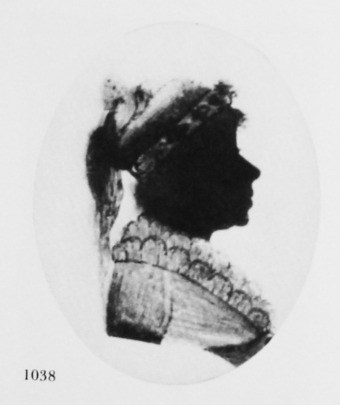
Queen Charlotte
Silhouette painted on convex glass
Before 1810
Frame: papier mâchl
By gracious permission of Her Majesty the Queen
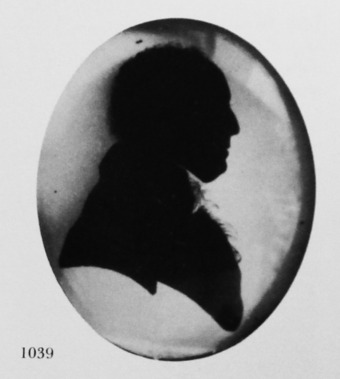
The Reverend Thomas Fuller
Silhouette painted on thick convex glass, originally backed with wax
c. 1810
2¼ x 2in./58 x 51mm.
Trade Label No. 2
Frame: oval, turned wood
The sitter (Rector of Heathfield, Vicar of Hove and Rector of Chalvington, Sussex) was born on 17 December 1754 and died on 10 December 1832.
Silhouettes by Gibbs of four of the sitter’s daughters are illustrated (196, 260, 1040, 1041).
Author’s collection
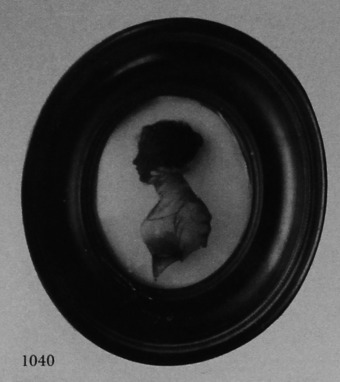
Maria-Jane Fuller
Silhouette painted on thick convex glass, originally backed with wax
c. 1810
2¼ x 2in./58 x 51mm.
Trade Label No. 2
Frame: oval, turned wood
The sitter was the sixth daughter of the Reverend Thomas Fuller (1039).
She married, first, Lieutenant Dixon (in 1812); second, the Reverend Thomas Raynes, Rector of Waldron, Sussex. She died on Christmas day, 1839.
Mrs Beaver collection

Mary Anne Fuller
Silhouette painted on thick convex glass, originally backed with wax
c. 1810
2¼ x 2in./58 x 51mm.
Trade Label No. 2
Frame: oval, turned wood
Author’s collection
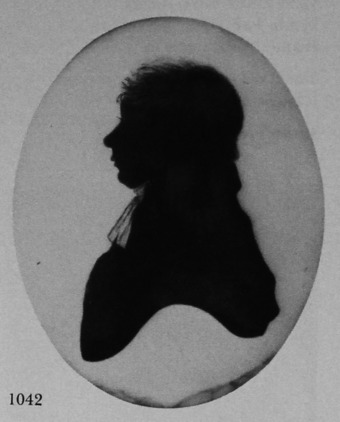
Unknown lawyer or cleric
Silhouette painted on convex glass
? c. 1812
3 3/8 x 2¾in./86 x 70mm.
Trade Label No. 3
Frame: papier mâché
Inscribed, ‘Octavius Vinba, the gift of her mother in 1851: not to be taken out of the frame until after my death – Mary Anne Vinba, 1852’. The bust-line differs from Gibbs’s usual type.
T. E. F. Sainsbury collection
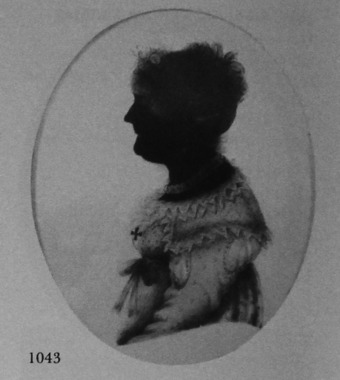
Mrs Neale
Silhouette painted on convex glass
c. 1819
3½ x 2¾in./90 x 70mm.
Frame: papier mâché
This especially fine silhouette, obviously by Gibbs, bears on the reverse the following inscription:
She visited the sick
She fed the haughty
She clothed the naked
She was hospitable
to her equals
Conciliatory to her inferiors
A firm supporter of religion
A warm friend and benevolent
neighbour
Such was Mrs. Neale
The original of this profile
M. A. H. Christie collection
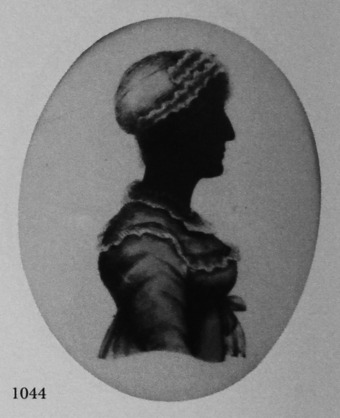
Unknown woman
Silhouette painted on convex glass
? c. 1819-21
3½ x 2¾in./90 x 70mm.
Trade Label No. 7
M. A. H. Christie collection
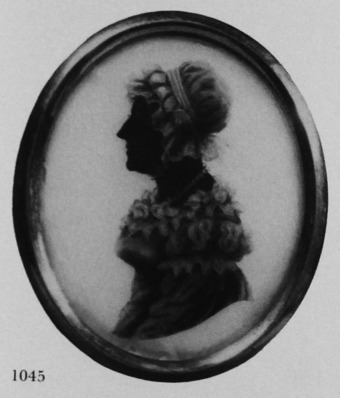
Unknown woman
Silhouette painted on convex glass
Probably 1820s
3¼ x 2¾in./83 x 70mm.
Trade Label No. 8
Frame: papier mâché
The probable date is suggested by the pronounced mancheron on the sitter’s dress, and by her cornette indoor cap.
J. A. Pollak collection
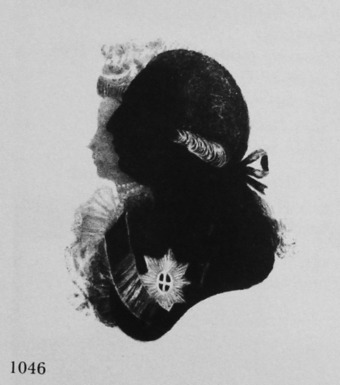
George III and Queen Charlotte
Double silhouette painted on convex glass
c. 1812
3¼ x 2½in./83 x 64mm.
Frame: paoier mâché, with ormolu surround
On the portrait of the King the detail is shown with a needle. The fingerprinted portrait of the Queen is visible behind. This silhouette, and its previous ascription to A. Charles, are discussed in the text.
By gracious permission of Her Majesty the Queen

Trade Label No. 1 of Hinton Gibbs.
Author’s collection
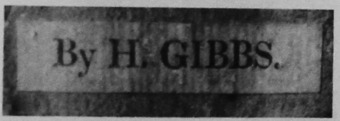
Trade Label No. 2 of Hinton Gibbs.
Author’s collection
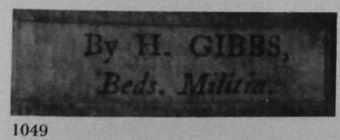
Trade Label No. 3 of Hinton Gibbs.
T. E. F. Sainsbury collection

Trade Label No. 4 of Hinton Gibbs.
M. A. H. Christie collection
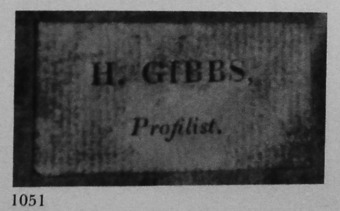
Trade Label No. 5 of Hinton Gibbs, from the silhouette shown in 1610.
Author’s collection
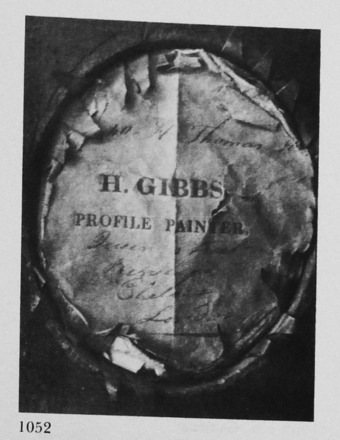
Trade Label No. 6 of Hinton Gibbs, from the silhouette shown in 1611.
By permission of the Right Hon. Earl Spencer

Trade Label No. 7 of Hinton Gibbs.
M. A. H. Christie collection

Trade Label No. 8 of Hinton Gibbs.
J. A. Pollak collection
DETAIL
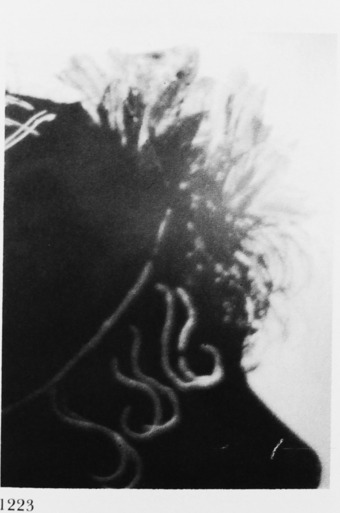
Woman’s cap. Detail from a silhouette by Hinton Gibbs. The artist has used a needle to show strands of hair against the sitter’s face. (1041)
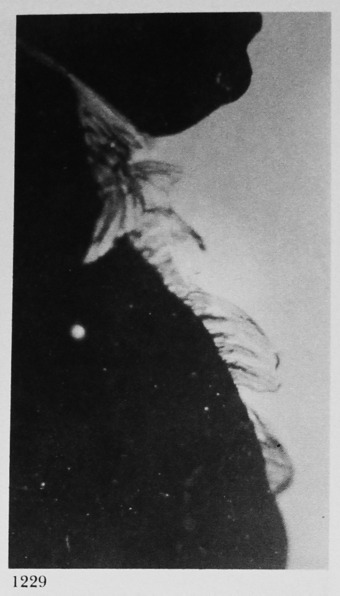
Shirt-frill. Detail from a silhouette of a man by Hinton Gibbs. There is no sign of the use of a needle. (1039)

Waist-line of a girl’s dress. Detail from a silhouette by HInton Gibbs. The transparent material is indicated by even fingerprinting. (1041)

Frances Fuller
Silhouette by Hinton Gibbs, 1811
costume dating points
The à la Titus hair-style.
The round-necked dress, worn with a ruff, apparently secured to the neck-line by a brooch.
This columnar neck—line, with the single ruff, is typical of the period.
The dress, of flimsy material and with a waist-line lower than it was to become in c. 1814.
Author’s collection

Unknown woman
Silhouette by Hinton Gibbs, probably 1818-21
costume dating points
The fringe over the forehead, fashionable at the end of the decade 1810-20.
The cornet cap, tied beneath the chin, small at the beginning of the 1820s, when only a chignon (not a knot) had to be accommodated.
The ruff, worn separately as a decoration.
The pelisse robe, which came into fashion at about this time, closed in the front with buttons all the way down.
The waist-line, still high (it was to return to its normal position in c. 1824).
M. A. H. Christie collection
Chapter 9
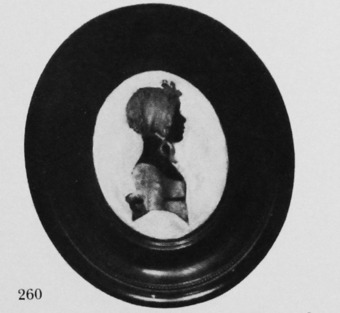
Lotte Fuller (aged about four), of Catedfield Park
Silhouette by Hinton Gibbs, 1810
costume dating points
This little girl is still wearing a cap.
The thin muslin dress, high-waisted and worn with a coloured sash, was almost standard wear for small girls at the time.
The sleeve, reaching to below the elbow.
Author’s collection
SECTION THREE
